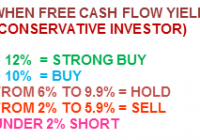Digging Beneath The Surface Of 2 Concentrated Value ETFs
Summary We have seen a big shift in investor appetite away from traditional value companies and into high flying growth names over the last several years. The August correction may afford an opportunity to purchase value ETFs at attractive prices when compared to broad equity benchmarks. Two relatively new ETFs came across my watch list as potential candidates for investors seeking an outside the box approach to value selection screens. We have seen a big shift in investor appetite away from traditional value companies and into high flying growth names over the last several years. That trend has continued in 2015, yet the recent volatility may have investors reconsidering the fundamental qualities of the stocks in their portfolio. Growth stocks tend to fall harder during corrective phases as investors flock to the safety of defensive or value-oriented sectors. Furthermore, the August correction may afford an opportunity to purchase value ETFs at attractive prices when compared to broad equity benchmarks. Two relatively new ETFs came across my watch list as potential candidates for investors seeking an outside the box approach to value selection screens. Both funds are built using a more concentrated portfolio focused on stocks with solid balance sheets and sound business qualities. ValueShares U.S. Quantitative Value ETF (BATS: QVAL ) QVAL is an actively managed ETF that debuted in late 2014 and has amassed over $50 million in assets spread amongst 40-50 individual holdings. This fund is managed by Wesley R. Gray, Ph.D. who has written extensively on the attributes of quantitative values and behavioral finance. QVAL uses three separate screening criteria to hone in on a focused number of stocks that it believes offer solid value alongside quality long-term business fundamentals. The goal is to invest in the cheapest, high quality stocks in order to try and outperform a more passive index. QVAL benchmarks its performance versus the iShares S&P 500 Value ETF (NYSEARCA: IVE ) and so far this year it has been able to maintain a similar total return. Prior to the recent correction, this actively managed ETF was actually significantly outperforming the passively managed yardstick. It’s worth pointing out that IVE is a market cap weighted index of 359 holdings, while QVAL takes a more equal weighted approach to its portfolio construction methodology. In addition, QVAL charges an expense ratio of 0.79%, compared to 0.18% for its passive counterpart. The significantly higher fees of the actively managed portfolio are to be expected for a unique strategy using proprietary screening and construction methodologies. Nevertheless, QVAL needs to prove that its approach adds value (pardon the pun) to investors that choose to step outside the passive index realm. In my opinion, this fund should warrant consideration for those seeking an alpha generating strategy for the value sleeve of their equity portfolio. Deep Value ETF (NYSEARCA: DVP ) DVP is another value-oriented strategy that debuted in 2014. This fund is based on the TWM Deep Value Index, which is constructed of 20 dividend paying stocks within the S&P 500 Index with solid balance sheets, earnings and strong free cash flow. According to the fund company website, the companies within the index are weighted based on a “rules-based assessment of their valuations so that stocks that are most attractively valued receive a higher weight.” In addition, the index is reconstituted annually. The extremely concentrated nature of the DVP portfolio makes for an interesting study in what is essentially a smart-beta index. The smaller number of holdings will likely create a greater divergence from the benchmark than a more traditional approach. This ETF will be more susceptible to individual business risks and opportunities of the underlying stocks than its peers as well. I would expect that the DVP portfolio will experience pronounced periods of underperformance and outperformance depending on the prevailing market environment . DVP has managed to accumulate over $200 million in total assets and charges a similar expense ratio as QVAL at 0.80%. This ETF is certainly worth a look for investors that like the comfort of a passive index with a stock picker’s mentality. The Bottom Line There are pros and cons to selecting ETFs that fall outside the traditional realm of low-cost and well-diversified benchmarks. However, both of these funds offer a unique approach to value investing that should not be overlooked. They can potentially add value as tactical positions that compliment your core ETF portfolio. Disclosure: I/we have no positions in any stocks mentioned, and no plans to initiate any positions within the next 72 hours. (More…) I wrote this article myself, and it expresses my own opinions. I am not receiving compensation for it. I have no business relationship with any company whose stock is mentioned in this article. Additional disclosure: David Fabian, FMD Capital Management, and/or clients may hold positions in the ETFs and mutual funds mentioned above. The commentary does not constitute individualized investment advice. The opinions offered herein are not personalized recommendations to buy, sell, or hold securities.
